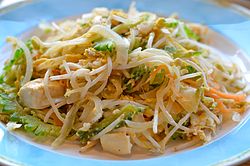food.wikisort.org - Dish
Chanpurū (チャンプルー) is an Okinawan stir fry dish. It is considered the representative dish of Okinawan cuisine.[1][2] Chanpurū generally consists of tofu combined with some kind of vegetable, meat, or fish.[2] Luncheon meat (such as American Spam or Danish Tulip), egg, moyashi (bean sprouts) and gōyā (bitter melon) are some other common ingredients. Spam is not typically used in mainland Japan; but it is more common in Okinawa due primarily to the historical influence of its introduction by the US Navy. Chanpurū is Okinawan for "something mixed" and the word is sometimes used to refer to the culture of Okinawa, as it can be seen as a mixture of traditional Okinawan, Chinese, mainland Japanese, Southeast Asian and North American culture. The term originates from the Malay and Indonesian word campur (pronounced "cham-poor"), meaning "mix".[3]
 Gōyā chanpurū | |
| Alternative names | チャンプルー |
|---|---|
| Type | Stir fry |
| Place of origin | Japan |
| Region or state | Okinawa Prefecture |
| Main ingredients | Tofu, vegetables |
Long a local specialty only found on Okinawa, chanpurū has in recent years, through television shows and increased interest in Okinawan culture, spread to many restaurants on mainland Japan.
Types of chanpurū
Gōyā chanpurū is the quintessential chanpurū. It consists of gōyā (bitter melon), egg, tofu, and either Spam or thinly sliced pork.[2][4] It often also includes vegetables such as carrots.
Tofu chanpurū is tofu stir-fried with vegetables and Spam, bacon, thinly sliced pork belly, or canned tuna. Unlike tofu from mainland Japan, Okinawan tofu is firm and does not fall apart when stir-fried.[2] It is considered best form to crumble the tofu into the frying pan by hand, so as to avoid uniform cubes.
Māmina chanpurū is a version of chanpurū that contains moyashi, or mung bean sprouts.[1][2]
Fu chanpurū is made using fu, a kind of wheat gluten. It is stir-fried with vegetables and a meat as above.
Sōmen chanpurū (somin chanpurū in Okinawan) includes sōmen, very thin noodles. They are stir-fried lightly in oil with green onions and meat as above.
See also
- Champloose
- List of tofu dishes
References
- "ちゃんぷるー" [Chanpuru]. Dijitaru Daijisen (in Japanese). Tokyo: Shogakukan. 2012. OCLC 56431036. Archived from the original on 2007-08-25. Retrieved 2012-12-17.
- "ちゃんぷるー" [Chanpuru]. Nihon Daihyakka Zensho (Nipponika) (in Japanese). Tokyo: Shogakukan. 2012. OCLC 153301537. Archived from the original on 2007-08-25. Retrieved 2012-12-17.
- 岸 朝子(きし・あさこ). "Chanpuru shokubunka" (in Japanese). doraku.asahi.com. Archived from the original on 2013-06-15. Retrieved 2011-11-03.
- "Goya Chanpuru". About.com Japanese Food. Retrieved September 7, 2011.
На других языках
- [en] Chanpurū
[ru] Тямпуру
Тямпуру (яп. チャンプルー тямпуру:) — популярное блюдо окинавской кухни, готовящееся обжариванием в масле овощей, тофу, мяса или рыбы. Также, в качестве ингредиентов часто используются мясные консервы, яйца, мояси и гоя. Само слово тямпуру на Окинаве означает смесь и иногда используется в отношении самого архипелага, подразумевая смешение различных культурных традиций: рюкюской, китайской, японской, американской и традиций юго-восточной Азии. Данное понятие родилось под влиянием индонезийской кухни, в частности, блюда наси чампур (индон. Nasi campur «рисовая смесь»)[1]Другой контент может иметь иную лицензию. Перед использованием материалов сайта WikiSort.org внимательно изучите правила лицензирования конкретных элементов наполнения сайта.
WikiSort.org - проект по пересортировке и дополнению контента Википедии